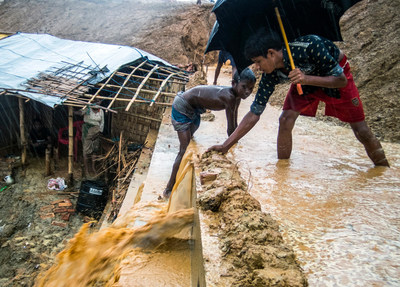Monsoon rains hit Rohingya refugee camps, raising risks for thousands of children
COX'S BAZAR, Bangladesh, June 14, 2018 /CNW/ - Torrential rain and strong winds hit Rohingya refugee camps and makeshift settlements in the past week, threatening the health and safety of thousands of children as the first major storm of the monsoon season arrived in south-eastern Bangladesh.

The heavy rain brought flooding and landslides ? with reports of one young child killed in a landslide ? whilst strong winds damaged or destroyed hundreds of shelters, leaving vulnerable families defenseless against the elements.
"Thousands of children and their families are living in shelters on hilly areas with no trees, rocks or shrubs to hold sandy ground ? much of which has now turned into mud - as the rains continue and the water table rises rapidly," said Edouard Beigbeder, UNICEF Representative in Bangladesh. "It's vital that refugees in the most vulnerable locations are able to move to safer locations, but many families ? who have already faced upheavals several times over the last few months -- are reluctant to abandon their makeshift homes."
UNICEF and partners estimate that 200,000 Rohingya refugees ? over 50 per cent of whom are children -- are currently threatened by the dual dangers of flooding and landslides, with 25,000 at highest risk.
A rapid assessment following the latest rains found that of the almost 10,000 refugees directly affected, over 65 per cent were affected by wind, more than one-in-four (27 per cent) by land-slides, and 4 per cent suffered from severe water-logging or flooding.
In addition, it is estimated that almost 900 shelters, 15 water points, over 200 latrines, two UNICEF-supported health facilities and two food distribution sites have been damaged or destroyed in the camps, with assessments ongoing, creating additional challenges for the affected population. Rehabilitation efforts are underway.
Most roads leading to the camps have been flooded, while the main military road that bisects the biggest settlement has been shut to all except medical vehicles.
Several learning centres and Child and Women Friendly Spaces run by UNICEF and its partners have been temporarily closed because of the bad weather, affecting thousands of women and children. The arrival of the monsoon rain also increases health risks within the camps, particularly water borne diseases such as acute watery diarrhea and cholera.
"As the monsoon rains intensify, so do the dangers that children face ? not only injury, separation or even death as a result of landslides and flooding, but also disease, and a lack of access to vital services including health and education," added Beigbeder. "Urgent support is needed to avert further catastrophe for thousands of children."
More than two and a half metres of rain are expected to fall in Cox's Bazar throughout June, July and August during the peak of the monsoon season, with more rains forecast to fall later this week.
Over the past few months UNICEF and partners have been working to mitigate the risk of the monsoon rains, including pre-positioning humanitarian supplies ? including tarpaulins and corrugated iron panelling -- to be mobilized as required.
Notes for editors:
Multimedia materials available here
About UNICEF
UNICEF has saved more children's lives than any other humanitarian organization. We work tirelessly to help children and their families, doing whatever it takes to ensure children survive. We provide children with healthcare and immunization, clean water, nutrition and food security, education, emergency relief and more.
UNICEF is supported entirely by voluntary donations and helps children regardless of race, religion or politics. As part of the UN, we are active in over 190 countries - more than any other organization. Our determination and our reach are unparalleled. Because nowhere is too far to go to help a child survive. For more information about UNICEF, please visit www.unicef.ca. For updates, follow us on Twitter and Facebook or visit unicef.ca.
SOURCE UNICEF Canada
News published on and distributed by:



